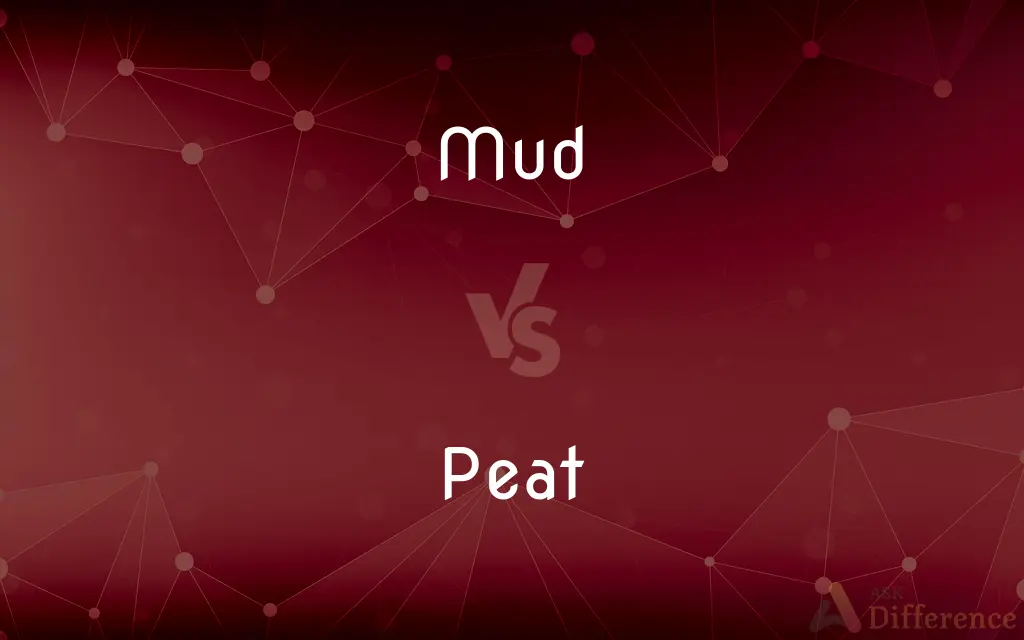Mud vs. Peat — What's the Difference?
By Fiza Rafique & Maham Liaqat — Updated on April 4, 2024
Mud is a mixture of water and soil or fine particles, commonly found in wet areas, while peat is a type of soil formed from partially decomposed plant material in water-saturated environments.

Difference Between Mud and Peat
Table of Contents
ADVERTISEMENT
Key Differences
Mud consists of water mixed with soil, silt, or clay, and it can form anywhere water and earth meet, such as at the bottom of lakes, rivers, and in wetlands. Peat, on the other hand, is an accumulation of partially decayed vegetation or organic matter that is unique to natural areas called peatlands.
While mud is often considered a nuisance in daily life, being sticky and messy when wet, and hard and potentially cracking when dry, peat is valued for its carbon sequestration abilities, its role in natural water filtration, and its use as a fuel and in gardening.
Mud can appear in a variety of contexts, from the muddy bottom of a pond to the muddy fields farmers might plow after the rain. Peat forms over thousands of years, requiring specific conditions of water saturation and lack of oxygen for the slow decomposition of plant material.
The composition of mud varies widely depending on its location and the types of rocks and organic material present in the area. Peat's composition is more consistent, being primarily composed of sphagnum moss, sedges, and other organic materials found in wetlands.
Mud is typically a temporary condition that changes with the weather and can dry out, while peat is a stable, long-term accumulation that can take centuries to form and may remain in its saturated state for millennia if conditions are maintained.
ADVERTISEMENT
Comparison Chart
Composition
Water mixed with soil, silt, or clay.
Partially decomposed vegetation or organic matter.
Formation
Can form in any wet area.
Forms in water-saturated environments over thousands of years.
Characteristics
Sticky when wet, can crack when dry.
Rich in carbon, absorbs water well.
Uses
Limited, often considered a nuisance.
Used as a fuel, in gardening, and for carbon sequestration.
Environmental Impact
Can be a natural part of wetland ecosystems, affecting water clarity and quality.
Plays a crucial role in water filtration, carbon sequestration, and habitat for specific wildlife.
Compare with Definitions
Mud
A mixture of water and soil or fine particles, commonly found in wet areas.
After the heavy rain, the backyard was covered in a thick layer of mud.
Peat
Formed from partially decomposed plant material in water-saturated environments.
The peat bog stretched for miles, a testament to centuries of accumulation.
Mud
Can be created artificially in various industries or occur naturally.
The construction site was bogged down with mud, slowing progress.
Peat
Has a high carbon content and is used as a fuel source in some regions.
They used blocks of peat for heating their homes in the rural countryside.
Mud
Often associated with negative impacts like making areas impassable.
The festival grounds turned into a muddy mess after the downpour.
Peat
Plays a crucial role in carbon sequestration and supporting biodiversity.
The peatland ecosystem is a vital habitat for unique flora and fauna.
Mud
Temporary and can dry out, changing its properties.
The sun-dried mud cracked, creating a patterned surface.
Peat
Absorbs a significant amount of water, which makes it useful in gardening.
Adding peat to the garden beds helped retain moisture during the dry spells.
Mud
Characteristics depend on the proportion of water to soil and the type of soil.
The riverbank mud was soft and squishy underfoot, making it difficult to walk.
Peat
Requires specific conditions to form and is considered a non-renewable resource in human timeframes.
Peat formation is a slow process, taking thousands of years to accumulate a few meters depth.
Mud
Mud is soil, loam, silt or clay mixed with water. It usually forms after rainfall or near water sources.
Peat
Peat (), sometimes known as turf (), is an accumulation of partially decayed vegetation or organic matter. It is unique to natural areas called peatlands, bogs, mires, moors, or muskegs.
Mud
A computer-based text or virtual reality game which several players play at the same time, interacting with each other as well as with characters controlled by the computer.
Peat
A brown deposit resembling soil, formed by the partial decomposition of vegetable matter in the wet acidic conditions of bogs and fens, and often cut out and dried for use as fuel and in gardening
A peat bog
Mulch plants with leaf mould or peat
Mud
A computer program, usually running over the internet, that allows multiple users to participate in virtual-reality role-playing games.
Peat
Partly decomposed vegetable matter, usually mosses, found in bogs and sometimes burned as fuel or mixed into soil to improve growing conditions.
Mud
Wet, sticky, soft earth, as on the banks of a river.
Peat
Soil formed of dead but not fully decayed plants found in bog areas, often burned as fuel.
Mud
(Slang) Wet plaster, mortar, or cement.
Peat
(obsolete) A pet, a darling; a woman.
Mud
Slanderous or defamatory charges or comments
Slinging mud at his opponent.
Peat
A small person; a pet; - sometimes used contemptuously.
Mud
To cover or spatter with or as if with mud.
Peat
A substance of vegetable origin, consisting of roots and fibers, moss, etc., in various stages of decomposition, and found, as a kind of turf or bog, usually in low situations, where it is always more or less saturated with water. It is often dried and used for fuel.
Mud
A mixture of water and soil or fine grained sediment.
Peat
Partially carbonized vegetable matter saturated with water; can be used as a fuel when dried
Mud
A plaster-like mixture used to texture or smooth drywall.
Mud
(construction industry slang) Wet concrete as it is being mixed, delivered and poured.
Mud
(figuratively) Willfully abusive, even slanderous remarks or claims, notably between political opponents.
The campaign issues got lost in all the mud from both parties.
Mud
(slang) Money, dough, especially when proceeding from dirty business.
Mud
(geology) A particle less than 62.5 microns in diameter, following the Wentworth scale
Mud
A black person.
Mud
Drilling fluid.
Mud
(slang) Coffee.
Mud
(transitive) To make muddy or dirty; to apply mud to (something).
Mud
(transitive) To make turbid.
Mud
(intransitive) To go under the mud, as an eel does.
Mud
To participate in a MUD or multi-user dungeon.
Mud
Earth and water mixed so as to be soft and adhesive.
Mud
To bury in mud.
Mud
To make muddy or turbid.
Mud
Water soaked soil; soft wet earth
Mud
Slanderous remarks or charges
Mud
Soil with mud, muck, or mire;
The child mucked up his shirt while playing ball in the garden
Mud
Plaster with mud
Common Curiosities
What makes peat environmentally significant?
Peat is significant for its carbon sequestration capabilities, role in water filtration, and as a habitat for specific wildlife.
Can mud have an environmental impact?
Yes, mud can impact water clarity and quality but is also a natural part of many ecosystems.
Can mud be beneficial?
While often seen as a nuisance, mud can play a crucial role in certain ecosystems, providing habitat and affecting nutrient cycles.
How do mud and peat differ in composition?
Mud is composed of water and fine earth materials, while peat consists of partially decayed vegetation and organic matter.
What are the uses of peat?
Peat is used as a fuel, in gardening for moisture retention, and for its environmental benefits like carbon sequestration.
How does the presence of mud affect human activities?
Mud can make areas impassable, hinder construction and agricultural activities, but can also be used beneficially in certain industries.
What is peat?
Peat is a type of soil formed from partially decomposed plant material in water-saturated environments, known for its carbon content and water retention.
Why is peat considered a non-renewable resource?
Peat is considered non-renewable because it forms very slowly, over millennia, making its extraction unsustainable over human timeframes.
Is all mud the same?
No, the characteristics of mud can vary widely depending on the water-to-soil ratio and the types of soil particles involved.
What is the significance of mud in natural habitats?
Mud can support a variety of life forms in wetland ecosystems and is vital for the breeding and feeding of certain wildlife species.
What is mud?
Mud is a wet mixture of water and soil, silt, or clay, often found in areas where water accumulates.
How are mud and peat formed?
Mud can form in any wet condition, while peat requires specific conditions of water saturation and lack of oxygen over thousands of years.
How does peat contribute to gardening?
Peat helps retain soil moisture and improve soil structure, making it valuable for gardening and agriculture.
How is peat harvested?
Peat is harvested by removing the top layer of bog vegetation, drying the underlying peat, and then cutting, collecting, and processing it for use.
What role does peat play in climate change?
Peatlands act as significant carbon sinks, storing vast amounts of carbon, and their preservation and restoration are important in combating climate change.
Share Your Discovery

Previous Comparison
Indemnity vs. Warranty
Next Comparison
Spigot vs. SpileAuthor Spotlight
Written by
Fiza RafiqueFiza Rafique is a skilled content writer at AskDifference.com, where she meticulously refines and enhances written pieces. Drawing from her vast editorial expertise, Fiza ensures clarity, accuracy, and precision in every article. Passionate about language, she continually seeks to elevate the quality of content for readers worldwide.
Co-written by
Maham Liaqat















































